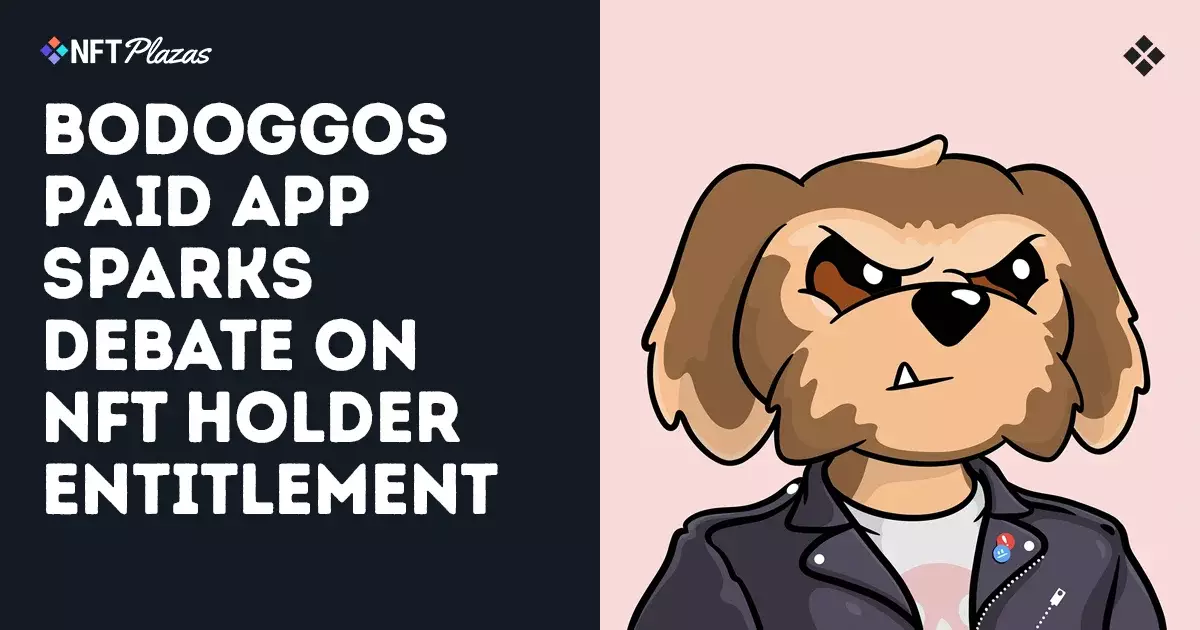In a vibrant, albeit tumultuous world, the NFT industry seems to be experiencing its latest upheaval thanks to an innocuous tweet from a community member. The tweet in question was aimed at the BoDoggos team, directly challenging their decision to impose a subscription fee on a newly launched trading news application tailored specifically for NFT holders. It appears to be a relatively straightforward issue on the surface: Should NFT owners be entitled to unfettered access to future products without incurring additional costs? However, this simple inquiry has sent ripples through the community, igniting a passionate debate that lays bare some uncomfortable truths about the NFT sector.
NFTs were initially marketed as revolutionary digital assets that would grant holders exclusive rights to various benefits, ranging from digital art ownership to access to exclusive events. Yet, the BoDoggos incident highlights a fundamental rift: the tension between the expectations of buyers and the financial realities of projects. As the argument unfolds, we are faced with a disconcerting possibility: Could it be that the relentless demand for continuous free access is preventing NFTs from achieving their true potential as viable business ventures?
The Cost of Creation: A Tough Reality Check
In the response to the aforementioned tweet, BoDoggos co-founder Nick O’Neill stood firm, defending the need for a subscription fee by outlining the substantial costs incurred in developing and maintaining the app. He raised an essential point about ongoing operational expenses, such as API fees, employee salaries, and other looming bills. Yet, in a sector rife with enthusiasts, the pressures to constantly deliver value for free not only undermine the sustainability of these digital ecosystems but also present significant hurdles for growth.
As prominent NFT figures, including Leon Abboud and Matt Medved, chimed in, they expressed a common concern: the expectation that a single purchase should equate to a lifetime of benefits could ultimately hinder the long-term viability of these projects. It’s startling to think that fervent support could paradoxically lead to stagnation, as creators find themselves caught between a rock and a hard place—desiring to innovate but hamstrung by the fear of alienating their loyal base.
The Myths That Fuel Discontent
To understand the crux of the ongoing debate, it’s vital to dissect the myths surrounding NFT ownership. The idea that purchasing a digital collectible equals entitlement to an endless stream of services is not only audacious but unrealistic. NFTs are not merely collectibles; they are part of the burgeoning Web3 ecosystem, encompassing businesses that must operate within the parameters of a free market.
This misconception—that the initial financial investment should cover a lifetime of benefits—could be one of the most damaging narratives in the NFT space. As discussions delve deeper, one begins to question what true value means within this context. Can we genuinely call ourselves pioneers in a new era of digital assets if we cling to outdated notions of ownership? If the NFT community aspires to gain mainstream acceptance, it may need to rethink these entrenched beliefs that often place undue stress on innovative projects.
A Call for Sustainable Practices
What remains abundantly clear in this debate is the urgent need for a paradigm shift. Stakeholders in the NFT ecosystem must reevaluate their expectations and embrace the complexity of running a digital business. It is essential to foster an environment where creators can build and innovate without incessant pressure to give more for less. Balancing the desire to reward supporters with the commercial realities of sustaining a viable project is the crux of the issue.
The focus should be on creating sustainable business models rather than succumbing to a culture of entitlement that may ultimately lead to the demise of promising projects. As digital assets evolve, so too must the mindsets of their holders. The time has come for both creators and collectors to unite in pursuit of common goals that value innovation while addressing the fiscal demands of running a modern-day digital enterprise. The apparent discord may serve as a wake-up call for NFT enthusiasts to consider how they can contribute to a more sustainable future for this groundbreaking technology.















